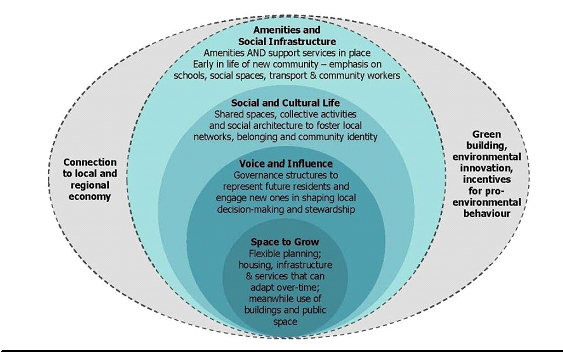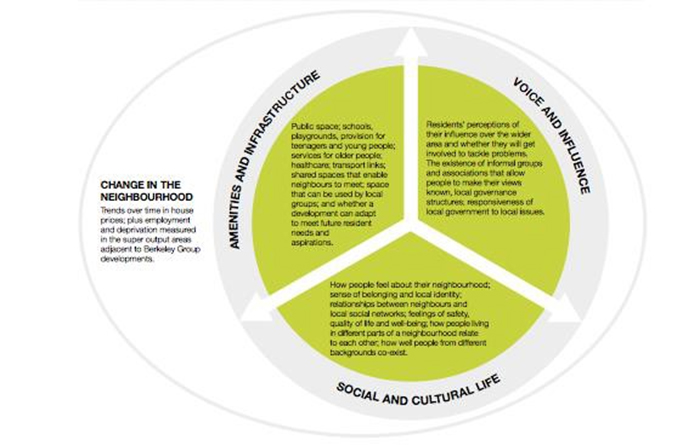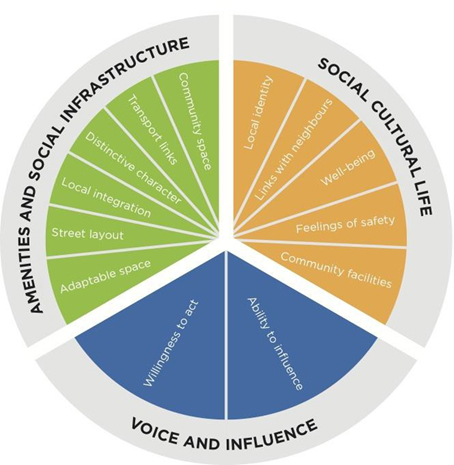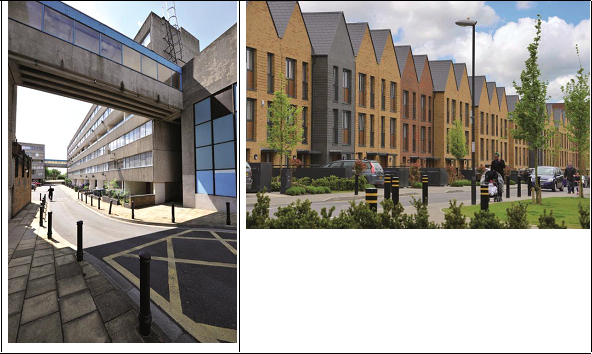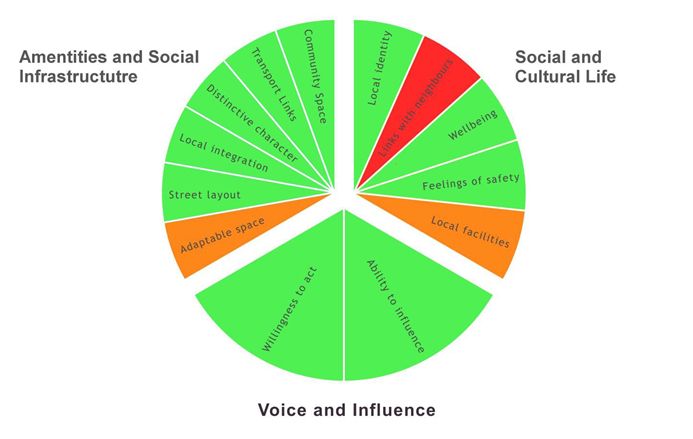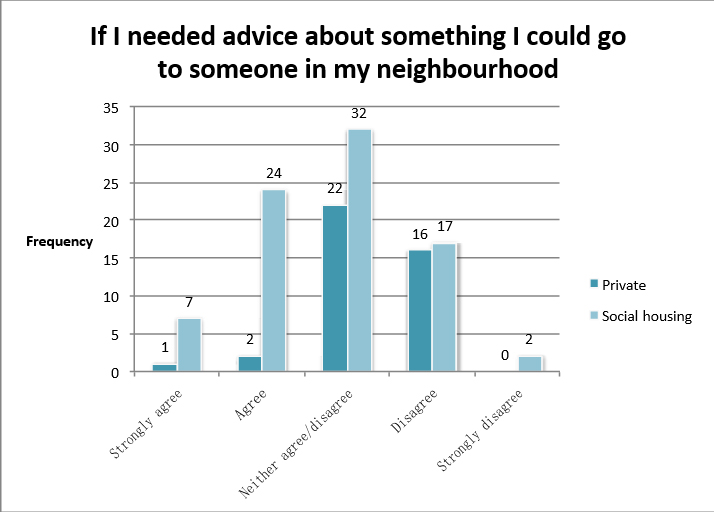Creating strong communities – measuring social sustainability in new housing development
Tim Dixon and Saffron Woodcraft look at the importance of social sustainability (including wellbeing) for housebuilders, present a framework for its measurement, report the results of applying the framework in practice, and discuss the policy and practice implications of such an approach. (This is an edited version of the paper which appeared in the November 2013 issue of Town and Country Planning). (3000 words, excluding abstract and references).
Contents |
Introduction
This article describes a social sustainability measurement framework developed jointly in a project carried out by Social Life and the University of Reading, commissioned by the Berkeley Group.(1) The article sets out in detail how social sustainability can be defined, how it can be measured, and the resultant implications of the research findings for policy and practice.
What is social sustainability, and why is it important to the housebuilding industry?
Previous academic work has identified that social sustainability brings together a number of different ideas about social equity, well-being, social needs and the sustainability of communities (see Table 1), often described in terms of social capital, social cohesion and wellbeing.(2-6) Housing and urban regeneration are strong themes throughout this work, as is the idea that the neighbourhood or local community is an appropriate scale for measurement.(7) Importantly, this work acknowledges that the practical and operational aspects of social sustainability are not well explored, clearly defined or well integrated in the policy and practice of urban planning and housing. (8)
Table 1
Urban social sustainability – contributory factors as identified in the review of literature
| Non-physical factors | Predominantly physical factors |
|
Education and training Social justice – inter- and intra- generational Participation and local democracy Health, quality of life and wellbeing Social inclusion (and eradication of social exclusion) Mixed tenure Fair distribution of income Social order Community cohesion (i.e. cohesion between and among different groups) Social networks Social interaction Sense of community and belonging Employment Residential stability (versus turnover) Active community organisations Cultural traditions |
Urbanity Attractive public realm Decent housing Local environmental quality and amenity Accessibility (for example to local services and facilities/employment/green space) Walkable neighbourhood – pedestrian friendly |
NB: The above factors are set out in no particular order
Source: The social dimension of sustainable development: defining urban social sustainability (7)
For housebuilders, any definition of social sustainability should focus not only on neighbourhood and community, but also on physical environment and social capital. In this respect, social sustainability can be seen as a life-enhancing condition, which also highlights the importance of ‘place-making’. A forward-thinking approach should to try to capture a longer-term ‘stewardship’ (or ‘place-keeping’) role. (9) This is important given that in the UK many large-scale new developments have had a chequered and controversial history.
Although the Garden Cities and Garden Suburbs projects of the past, and other recent projects such as Granary Wharf in Leeds and Tibby’s Triangle in Southwold, took the ideas of Geddes and Howard seriously, and continue to flourish, other high-profile developments continue to attract controversy.
In this respect, the linkages between good design and people’s wellbeing and sense of place are well understood. Our research therefore defined social sustainability as follows:
‘Social' sustainability [is] about people’s quality of life, now and in the future. Social sustainability describes the extent to which a neighbourhood supports individual and collective well-being. It combines design of the physical environment with a focus on how the people who live in and use a space relate to each other and function as a community. It is enhanced by development which provides the right infrastructure to support a strong social and cultural life, opportunities for people to get involved, and scope for the place and the community to evolve.’
Social sustainability – a framework for measurement
Using this definition, and building on previous work by Social Life (11) and other research (15) the aim of the project was to create a practical and cost-effective way of measuring peoples’ quality of life and the strength of community across the Berkeley portfolio.
The starting point for the project was a practical framework developed by Social Life, with the Homes and Communities Agency, to aid understanding of social sustainability in new communities (see Fig. 1).
Fig. 1 Future communities – a framework for creating socially sustainable new communities
Source: Living at Kidbrooke Village (12)
This work was adapted for the Berkeley Group, and a framework and a set of metrics were developed to measure the experience of residents living in new housing developments against the definition of social sustainability. The final framework consists of three dimensions (see Fig. 2):
- ‘Amenities and infrastructure’ captures past attempts to lay the foundations for a thriving community through housing mix, public realm, landscaping, transport connections and community infrastructure.
- ‘Social and cultural life’ illustrates the present – how people experience the development and how this contributes to their quality of life, perceptions of safety, feelings of belonging and interaction with neighbours.
- ‘Voice and influence’ illustrates residents’ potential to shape their future through opportunities to engage.
A fourth dimension, ‘change in the neighbourhood’, captures the impact over time of a new community on the surrounding neighbourhoods and wider area. It was identified as important to a practical assessment of social sustainability at the local level, in particular for understanding how new development changes the demographic profile of a neighbourhood and housing affordability. However, this dimension was not included in the final framework for the Berkeley Group because the chosen research method involved benchmarking primary survey data against the 2011 Census, which was not available at the time. This data is now available for analysis and the Social Life team is exploring how this data could be applied.
Fig. 2 Four dimensions of the social sustainability framework
Source: Creating Strong Communities (10)
The three different dimensions of the framework contain 13 different indicators. Each indicator is informed by a number of different questions, drawn primarily from pre-existing national datasets or industry-standard assessment tools. In total, 45 different questions were used to inform the indicators. This approach was chosen because the research team wanted, where possible, to develop a resident survey and site survey that used pre-tested and validated questions, and to be able to benchmark the resident survey findings against national datasets.
The indicators for the ‘social and cultural life’ and ‘voice and influence’ dimensions were created by selecting questions from four national datasets: the Understanding Society Survey, the Taking Part Survey, the Crime Survey for England and Wales, and the Citizenship Survey. A number of questions were created for the social and cultural life dimension where appropriate questions did not already exist.
Table 2
National surveys included in the analysis
|
British Household Panel Survey/Understanding Society study (BHPS/US) Institute for Social and Economic Research: 1996 to the present
Department of Culture Media and Sport: 2005 to the present
Crime Survey for England and Wales (formerly the British Crime Survey) Home Office: 1986 to the present
Citizenship Survey Department for Communities and Local Government: 2001 to 2011 (biannual to 2007, annual 2008 to 2011)
|
The indicators from the ‘amenities and infrastructure’ dimension of the framework were created by selecting questions from the Building for Life (13) assessment tool, an industry standard that is endorsed by the UK Government; from the Public Transport Accessibility Level (PTAL) tool (an assessment used widely in London); and from additional sources of secondary data about residents’ travel habits. Additionally, a number of questions were created for this dimension where appropriate questions did not already exist.
The framework was tested initially during 2011-2012 on four different housing developments that had been completed in the past five years (see Table 3 for summary details). On each of the four sites an independent resident survey and site survey were carried out, and a small number of contextual interviews with local stakeholders (such as the estate manager, community representatives or residents associations, local businesses, one or more housing associations, a ward councillor, and council officers) provided additional qualitative insights to aid interpretation of the survey results. In total, 598 face-to-face interviews were carried out with residents of the four housing developments. A quota sampling method was used to ensure that the survey responses reflected the tenure mix for each housing development.
Further work was then also conducted on two additional developments – Beaufort Park in Colindale, North London, and Kidbrooke Village in Greenwich, South London, during 2012-2013 (see Table 3).
Table 3
| Name of development | Typology | Period of study | Location | Brief description* |
| Empire Square | Regeneration | 2011-2012 | Inner city: In the London Borough of Southwark, South London | Former warehouse site. 567 homes – 30% affordable |
| The Hamptons | Suburban dwellings | 2011-2012 | Suburban: In the London Borough of Sutton, South West London | Former sewage works. 645 homes – 33% affordable |
| Imperial Wharf | Urban | 2011-2012 | Inner city: In the London Borough of Hammersmith and Fulham | Former gas works. 1,428 homes – 47% affordable |
| Knowle Village | Rural/semi-rural | 2011-2012 | Rural: In the Winchester City Council area, Hampshire | Former hospital for the mentally ill. 701 homes – 31% affordable |
| Beaufort Park | Area regeneration | 2012-2013 | Suburban: In the London Borough of Barnet, North London | Former RAF site. 1,150 homes completed (of a total of 2,990 planned) – 30% affordable (approximately 50% socially rented, 25% shared ownership, 25% discount market sale) |
| Kidbrooke Village | Regeneration | 2012-2013 | Suburban: In the London Borough of Greenwich, South London | Site of former Ferrier Estate. 519 homes completed (of a total of 4,800 planned) – 50% affordable in early stages of development; on completion 38% affordable |
In all the case study sites the results of the resident surveys were benchmarked against geo-demographic classifications. The Office of National Statistics’ Output Area Classification (OAC) was used for questions taken from the Understanding Society study and Taking Part survey, and the Index of Multiple Deprivation (IMD) was used for the Crime Survey for England and Wales and the Citizenship Survey. This enabled comparison to be made between the responses of people living in Berkeley housing developments and the average responses that would be expected for people from comparable social groups in comparable areas.
The differences between the actual and expected scores were subjected to statistical testing. These results were then used to populate the ‘voice and influence’ and ‘social and cultural life’ dimensions of the framework. These benchmarks are referred to as the ‘benchmarks for comparable places’. A small number of questions underpinning the ‘social and cultural life’ dimension were created specifically for the framework to fill gaps where there were no appropriate pre-existing questions from national surveys. Consequently, it was not possible to benchmark the results of these questions, so an assessment was generated by comparing results across the sites.
The results for the ‘amenities and infrastructure’ dimension of the framework were based on the site survey, which followed the structure and scoring system of the original Building for Life survey, and a combination of PTAL scores and assessments of secondary data about residents’ travel patterns and transport provision on the developments.
A RAG (red-amber-green) rating system was developed to provide a simple graphic representation of the results – where green indicates a positive result which is higher or better than would be expected; amber a satisfactory result in line with the benchmark for a comparable place; and red a negative response, lower than would be expected (see Fig. 3).
The RAG rating system was adopted to present the results in a form that is practical and meaningful for different audiences, and to enable presentation of a range of responses rather than a single social sustainability ‘score’.
Fig. 3 Indicators in the Berkeley Group social sustainability framework
Source: Living at Kidbrooke Village (12)
Interpreting the results – a case study example of Kidbrooke Village
Kidbrooke Village in the Royal Borough of Greenwich, South East London is the most recent Berkeley Group development to be assessed using this method. The development is a £1 billion regeneration project which, over the next 15-20 years, will create a new suburban community on the site of the former Ferrier Estate (see Fig 4). It is currently one of the largest regeneration projects in the UK and has been planned to provide a new mixed- tenure, mixed-used community with 4,800 homes, schools, shops, health facilities, restaurants, offices, community facilities and open spaces.
A social sustainability assessment was undertaken at the beginning of 2013. An independent site survey was also carried out, and 125 residents (24% of occupied households) were interviewed using random sampling and tenure-based quotas. Fig. 5 shows the resulting RAG ratings (derived from statistical comparisons with national benchmarks) against the 13 indicators in the framework.
Fig. 4 Kidbrooke Village: before and after development
Fig. 5 shows that 10 of the 13 indicators are positive for Kidbrooke Village, which means that residents’ experiences were above the benchmarks for comparable places. Two of the indicators – adaptable space and local facilities – are rated as satisfactory, which means a comparable experience to the benchmarks. One of the indicators – links with neighbours – is red, meaning that the residents reported experiences below the benchmarks for comparable places.
Analysis of the qualitative interviews and the resident and site surveys behind the RAG ratings suggest that the majority of people currently living at Kidbrooke Village already feel settled and secure and feel that they ‘belong’ in the community.
Although Kidbrooke Village is a new community, many of the first residents are returning to the neighbourhood, having previously lived on the Ferrier Estate. The research shows that ‘old and new’ residents are getting along well, and social housing providers report that returning residents are very happy with the quality of their new homes and with the improvements to the public realm. Much work has been done by housing providers and others to make sure that residents who are returning to Kidbrooke Village are housed close to people they know. Arguably, this is reflected in the high levels of belonging and satisfaction that many residents report, which translate into positive indicators for wellbeing and local identity.
Fig. 5 Kidbrooke Village social sustainability assessment
Source: 'Living at Kidbrooke Village (12)
However, Kidbrooke Village residents report relatively low levels of interaction with their neighbours compared with the benchmark, which is why the ‘links with neighbours’ indicator is red (see Fig. 5). This result is not surprising given that almost 77% of survey respondents had lived in their homes for a year or less. This indicator includes six separate questions, three of which are about regularly talking to neighbours, exchanging favours with neighbours, and seeking advice from neighbours. Residents living in social or affordable housing reported higher rates of neighbourly behaviour than private residents: they were more likely to regularly speak to other neighbours, to have local support networks to call on, and to feel that people could be trusted – again reflecting the return of previous residents.
Fig. 6 Links with neighbours – responses by tenure type
Source: Kidbrooke Village Residents Survey, conducted by Social Life/ComRes, 2012
Both of the indicators measuring voice and influence were rated as positive, which reflects high levels of consultation on environment and success in achieving change. Over 71% agree they can influence decisions affecting the local area.
Five of the indicators measuring the amenities and infrastructure were positive and one was satisfactory. These indicators are assessed through an independent site survey. The architecture and high-quality materials used in the residential and public areas were felt to be important in giving Kidbrooke Village a distinctive character. Spatial planning and design have also been used to create streets and open spaces that are intended to be friendly, and to encourage interaction between neighbours. Particular attention has been paid to making sure that the same high standards of design and materials are used in all housing types, so that there is no visible difference between different tenures.
Kidbrooke Village also received a satisfactory rating for the adaptable space indicator. All family homes have small back gardens, which provide residents with the possibility of undertaking small future building extensions/adaptations. The development includes a variety of open spaces that could be seen as opportunities to involve residents in making decisions about use, design and long-term management of the public realm.
Implications for policy and practice
The measurement framework has been designed for a particular housing developer. The focus was therefore on the aspects of community strength and quality of life that a housebuilder could reasonably be held directly accountable for, or could influence through relationships with public agencies. Therefore measures focused on social equity and justice and access to education and employment have been excluded where they are beyond the control or influence of a housebuilder. (14)
However, this research is important because it is the first time that a housebuilder in the UK has attempted to operationalise and measure social sustainability (which includes well-being). The Berkeley Group is now intending to mainstream this approach. This work, and the Kidbrooke Village case study, demonstrates that it is possible to measure how residents experience life in a new neighbourhood, to understand how new communities start to form, and to identify how to intervene and support new places to flourish. Of course, not every development will produce a set of green indicators, but learning from the past can avoid the same mistakes in design and resident support being repeated in the future.
Moreover, this should all matter greatly to the housebuilding industry and planning authorities. The Government’s wellbeing agenda and the National Planning Policy Framework both raise questions about what sustainable development means in practice, and about the role of developers, local government and public agencies in creating successful new communities. (15)
Although housebuilders are increasingly good at creating safe, well maintained places, the industry as a whole lacks the tools to understand, and therefore to support, the social fabric of the new communities they are building. Housing need and a lack of public funding, along with new policy frameworks that emphasise wellbeing and sustainability, make it increasingly important to create this knowledge. It needs to be embedded across all the organisations involved in planning, development and estate management. The industry needs to interrogate what is known about developing sustainable communities and start to address the research gaps.
The value of creating places that are environmentally sustainable is widely accepted, and we have the evidence and the tools to act on this knowledge. Social sustainability, by contrast, is still a relatively new concept in the UK. It demands fresh evidence, new language and new tools to operationalise this crucial area of policy.
Tim Dixon is Professor in Sustainable Futures in the Built Environment in the School of Construction Management and Engineering, University of Reading. Saffron Woodcraft is co-founder and Director of Social Life, a new social enterprise created by the Young Foundation in 2012 to develop the Foundation’s work on social sustainability and innovation in placemaking.
This paper was entered into a competition launched by --BRE Group and UBM called to investigate the link between buildings and the wellbeing of those who occupy them.
Notes
- This social sustainability measurement framework which was developed jointly by Social Life and Professor Tim Dixon of the School of Construction Management and Engineering at the University of Reading. Full details of the project can be found in the report Creating Strong Communities, co-authored by Nicola Bacon, Douglas Cochrane, Saffron Woodcraft and Dr John Brown, and published by the Berkeley Group in September 2012 (see note 10, below). The research team is continuing the development and implementation of the framework in conjunction with Berkeley and other housebuilders. Further information on the research is available at www.berkeleygroup.co.uk/sustainability/social
- T. Dixon: Putting the S Word back into Sustainability: Can We Be More Social? The Berkeley Group.
- S. Woodcraft: ‘Social sustainability and new communities: moving from concept to practice in the UK’. Procedia – Social & Behavioral Sciences, 2012, Vol. 68, 29-42.
- J. Agyeman and B. Evans: 2004. ‘Just sustainability’: the emerging discourse of environmental justice in Britain?’. The Geographical Journal, 2004, Vol. 170 (2)
- S. Vallance, H.C. Perkins and J.E. Dixon: ‘What is social sustainability? A clarification of concepts’. Geoforum, 2011, Vol. 42, 342-8
- T. Dixon: ‘The property industry and the construction of urban spaces: crisis or opportunity?’. In J. Flint and M. Raco (Eds): The Future of Sustainable Cities. Policy Press, 2011
- N. Dempsey, G. Bramley, S. Power and C. Brown: ‘The social dimension of sustainable development: defining urban social sustainability’. Sustainable Development, 2011, Vol. 19 (5), 289- 300
- C. Weingaertner and Å. Moberg: ‘Exploring social sustainability: learning from perspectives on urban development and companies and products’. Sustainable Development, 2011 (http://doi.wiley.com/10.1002/sd.536)
- N. Dempsey, H.C. Smith and M. Burton (Eds): Place-Keeping: Open Space Management in Practice. Routledge, 2013
- N. Bacon, D. Cochrane, S. Woodcraft and J. Brown: Creating Strong Communities: How to Measure the Social Sustainability of New Housing Developments. The Berkeley Group, 2012. www.social-life.co/media/files/Creating_Strong_Communities.pdf.
- S. Woodcraft, N. Bacon, L. Caistor-Arendar, and T. Hackett: Design for Social Sustainability: A Framework for Creating Thriving New Communities. Social Life/Young Foundation, 2012.
- S. Woodcraft and N. Bacon: Living at Kidbrooke Village. The Berkeley Group, 2013. www.social-life.co/media/files/Living_at_Kidbrooke_Village.pdf.
- Building for Life is an assessment tool developed by the Commission for Architecture and the Built Environment.
- The research team is exploring how to incorporate the ‘change in the neighbourhood’ dimension into the framework. This will enable analysis of the impact of new housing developments on a wider area over time – in particular, changes in the demographic profile of surrounding neighbourhoods, in health and education outcomes, in employment and income, and in housing affordability. This information will be valuable in understanding the long-term social effects of building new housing and in developing new thinking about how to mitigate some of the challenges faced by many neighbourhoods, such as the impact of long-term disadvantage.
- A. Colantonio and T. Dixon: Measuring Socially Sustainable Urban Regeneration in Europe: Final Report for EIB. Oxford Institute for Sustainable Development, for the EIBURS (European Investment Bank University Research Sponsorship) Programme, 2009. http://oisd.brookes.ac.uk/sustainable_communities/resources/Social_Sustainability_and_Urban_Rege neration_report.pdf
Featured articles and news
RTPI leader to become new CIOB Chief Executive Officer
Dr Victoria Hills MRTPI, FICE to take over after Caroline Gumble’s departure.
Social and affordable housing, a long term plan for delivery
The “Delivering a Decade of Renewal for Social and Affordable Housing” strategy sets out future path.
A change to adoptive architecture
Effects of global weather warming on architectural detailing, material choice and human interaction.
The proposed publicly owned and backed subsidiary of Homes England, to facilitate new homes.
How big is the problem and what can we do to mitigate the effects?
Overheating guidance and tools for building designers
A number of cool guides to help with the heat.
The UK's Modern Industrial Strategy: A 10 year plan
Previous consultation criticism, current key elements and general support with some persisting reservations.
Building Safety Regulator reforms
New roles, new staff and a new fast track service pave the way for a single construction regulator.
Architectural Technologist CPDs and Communications
CIAT CPD… and how you can do it!
Cooling centres and cool spaces
Managing extreme heat in cities by directing the public to places for heat stress relief and water sources.
Winter gardens: A brief history and warm variations
Extending the season with glass in different forms and terms.
Restoring Great Yarmouth's Winter Gardens
Transforming one of the least sustainable constructions imaginable.
Construction Skills Mission Board launch sector drive
Newly formed government and industry collaboration set strategy for recruiting an additional 100,000 construction workers a year.
New Architects Code comes into effect in September 2025
ARB Architects Code of Conduct and Practice available with ongoing consultation regarding guidance.
Welsh Skills Body (Medr) launches ambitious plan
The new skills body brings together funding and regulation of tertiary education and research for the devolved nation.
Paul Gandy FCIOB announced as next CIOB President
Former Tilbury Douglas CEO takes helm.
UK Infrastructure: A 10 Year Strategy. In brief with reactions
With the National Infrastructure and Service Transformation Authority (NISTA).







